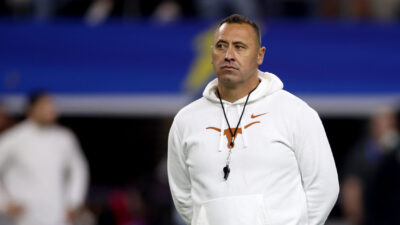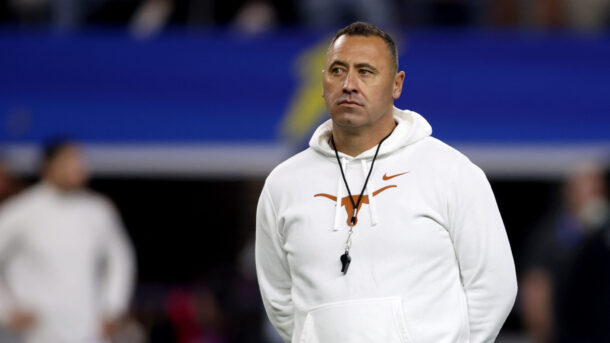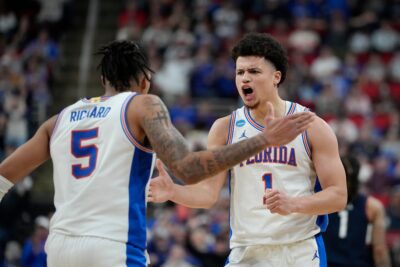Ad Disclosure
The Biggest Upsets in March Madness History
By Chris Wright
Last Updated:
Never say never.
Never in March Madness history had a No. 16 seed upset a No. 1 seed.
Until it happened. Until No. 16 seed Maryland-Baltimore County stunned No. 1 seed Virginia in the opening round of the 2018 NCAA Tournament, making history in the process.
Biggest Upsets in March Madness
Twice, a No. 16 seed has upset a No. 1 seed in the opening round. Eleven times, a No. 15 seed has upset a No. 2 seed in the opening round (or Second Round, when the NCAA briefly counted First Four games as First-Round games).
| YEAR | WINNER | LOSER | ROUND |
| 2023 | No. 16 seed Fairleigh Dickinson | No. 1 seed Purdue | First Round |
| 2018 | No. 16 seed Maryland-Baltimore County | No. 1 seed Virginia | First Round |
| 2023 | No. 15 seed Princeton | No. 2 seed Arizona | First Round |
| 2022 | No. 15 seed Saint Peter’s | No. 2 seed Kentucky | First Round |
| 2022 | No. 15 seed Saint Peter’s | No. 7 seed Murray State | Second Round |
| 2022 | No. 15 seed Saint Peter’s | No. 3 seed Purdue | Sweet 16 |
| 2021 | No. 15 seed Oral Roberts | No. 2 seed Ohio State | First Round |
| 2021 | No. 15 seed Oral Roberts | No. 7 seed Florida | Second Round |
| 2016 | No. 15 seed Middle Tennessee | No. 2 seed Michigan State | First Round |
| 2013 | No. 15 Florida Gulf Coast | No. 2 seed Georgetown | Second Round* |
| 2013 | No. 15 Florida Gulf Coast | No. 7 seed San Diego State | Third Round* |
| 2012 | No. 15 seed Lehigh | No. 2 seed Duke | Second Round* |
| 2012 | No. 15 seed Norfolk State | No. 2 seed Missouri | Second Round* |
| 2001 | No. 15 seed Hampton | No. 2 seed Iowa State | First Round |
| 1997 | No. 15 seed Coppin State | No. 2 seed South Carolina | First Round |
| 1993 | No. 15 seed Santa Clara | No. 2 seed Arizona | First Round |
| 1991 | No. 15 seed Richmond | No. 2 seed Syracuse | First Round |
* – The NCAA briefly listed “First Four” games as First-Round games, pushing traditional opening-round games into the “Second Round.”
Number of Upsets By Seed in March Madness
This chart shows how many NCAA Tournament upsets seeds No. 10 through No. 16 have delivered in March Madness. A No. 16 seed has pulled off 2 upsets. A No. 15 seed has delivered 15 upsets, etc. Seeding began in 1979; every field since 1985 has included 16 seeds in all four Regions.
| SEED | UPSETS | BEST RESULT |
| 16 | 2 | Won First Round |
| 15 | 15 | Lost in Elite 8 |
| 14 | 25 | Lost in Sweet 16 |
| 13 | 39 | Lost in Sweet 16 |
| 12 | 82 | Lost in Elite 8 |
| 11 | 110 | Lost in Final Four |
| 10 | 98 | Lost in Final Four |
Biggest Upsets in Final Four History
To qualify for this list, a team had to be seeded at least 5 lower than the team it beat in the Final Four.
| YEAR | WINNER | LOSER | ROUND |
| 2022 | No. 8 seed North Carolina | No. 2 seed Duke | Final Four |
| 2014 | No. 8 seed Kentucky | No. 2 seed Wisconsin | Final Four |
| 1988 | No. 6 seed Kansas | No. 1 seed Oklahoma | Championship |
| 1985 | No. 8 seed Villanova | No. 1 seed Georgetown | Championship |
| 1985 | No. 8 seed Villanova | No. 2 seed Memphis | Final Four |
| 1983 | No. 6 seed NC State | No. 1 seed Houston | Championship |
Ranking The 6 Biggest Upsets in NCAA Tournament History
This is a completely subjective ranking, taking into consideration the history made, the round and other circumstances.
6. No. 16 Fairleigh Dickinson defeated No. 1 Purdue (2023)
It wasn’t historic, thanks to UMBC’s upset win over Virginia in 2018, but this remains just the second time in NCAA Tournament history that a No. 16 seed eliminated a No. 1 seed in the opening round.
5. No. 15 Richmond defeated No. 2 Syracuse (1991)
Giant-killer Richmond delivered the biggest opening-round upset to date in the newly expanded, 64-team format, stunning a Syracuse squad that won the rugged Big East and featured 3 future NBA players in Billy Owens, Dave Johnson and LeRon Ellis.
This win cemented the Spiders’ reputation as a Giant-killer. In 1984, the No. 12 seed Spiders upset No. 5 Auburn in its first-round game. In 1988, No. 13 seed Richmond upset No. 4 seed Indiana and No. 5 seed Georgia Tech to make the Sweet 16.
4. No. 16 UMBC defeated No. 1 Virginia (2018)
It had never happened, until it did.
And when Maryland-Baltimore County became the first No. 16 seed to upset a No. 1 seed, the 74-54 beatdown was so quick, so thorough, it almost seemed as if the seeds had been reversed.
UMBC scored on its opening possession of the second half to take a 23-21 lead — and never looked back.
Four minutes into the second half, UMBC had increased its lead to 10 — and Virginia never got closer.
3. No. 8 North Carolina defeated No. 2 Duke (2022 Final Four)
North Carolina became the third No. 8 seed to upset a No. 2 seed in the Final Four, but the circumstances give the Tar Heels the edge.
This turned out to be the final game of Hall of Fame Duke coach Mike Krzyzewski’s career — and it was the first time the bitter rivals had ever met in the NCAA Tournament.
Duke led by 1 point with 1:01 left when UNC guard RJ Davis made 2 free throws to give the Tar Heels the lead. But teammate Caleb Love delivered the dagger — a 3-pointer with 28 seconds left that extended UNC’s lead to 4 and clinched the Tar Heels’ second consecutive victory over Coach K and biggest win in series history.
2. No. 8 Villanova defeated No. 1 Georgetown (1985 national championship)
Nobody gave Villanova a chance — and why would they?
Georgetown was the defending national champion and spent the entire 1984-85 season ranked No. 1 or No. 2 in the AP Poll.
The Hoyas’ lineup featured 5 future NBA players, including senior All-American Patrick Ewing, the most dominant force in the college game that season.
Georgetown swept Villanova in the regular season, too, but both games were tight enough to give the Wildcats hope entering the national championship game. Close calls in the NCAA Tournament fueled that belief, too. Villanova won its first 3 NCAA Tournament games by 2, 4 and 3 points. It won its Final Four semifinal against Memphis by 7.
Villanova had lost 10 games, but the Wildcats had talent. Ed Pinckney was 1 of 3 eventual NBA players on the roster, but Villanova knew it would have to play near-perfect basketball to upset Georgetown.
And it did.
Villanova missed just 1 shot in the second half — and unlikely hero Harold Jensen played the game of his life, making all 5 of his shots en route to 14 points as Villanova held on for a shocking 66-64 victory.
1. No. 6 NC State defeated No. 1 Houston (1983 national championship)
NC State might have been a lower seed in a bigger field, but the 1983 NCAA Tournament still featured just 48 teams and included first-round byes for the 16 highest-seeded teams. The lowest seeds in the tournament were No. 12.
That’s the only reason NC State received a No. 6 seed instead of, say, a No. 8 seed in a 64-team draw.
The Wolfpack were 16-10 entering the final game of the regular season — and proceeded to win their next 10 games.
They entered the ACC Tournament essentially needing to win that event just to qualify for the NCAA Tournament.
It was anything but easy. They survived Wake Forest in the opening game of the ACC Tournament, winning 71-70. They needed overtime to slip past Michael Jordan and North Carolina in the semifinals, and upset Ralph Sampson and Virginia 81-78 to win the ACC Tournament and secure an automatic bid into March Madness.
The drama didn’t stop.
NC State needed 2 overtimes to sneak past Pepperdine in the opening round of the NCAA Tournament. The survived UNLV, 71-70, in the second round. The “Cardiac Pack” captured the nation’s attention with their signature style of play: “Survive and Advance.”
After handling Utah in the Sweet 16, they encountered Sampson again in the Elite Eight, this time with a spot in the Final Four at stake. Sampson was brilliant, scoring 23 in his final game as a collegian, but no other Cavalier reached double figures. Once again, the Pack survived, winning 63-62.
They had an easier time beating Georgia in the Final Four to reach the national championship game. All that did was prompt questions about much they’d get blown out by against No. 1 Houston, led by eventual Hall of Famers Hakeem Olajuwon and Clyde Drexler.
The Cougars were an absolute juggernaut, averaging 82.4 points and earning the nickname “Phi Slama Jama” for their propensity to deliver highlight reel dunks.
Houston entered the national championship game riding an 26-game winning streak; 19 of those wins were by double digits.
Houston was a 7-point favorite, but NC State played fearless from the start. The Pack stormed to a 33-25 halftime lead and then held on for dear life.
Houston rallied to tie the game at 52 in the final minute. NC State called timeout and started its final possession with 42 seconds remaining. The Wolfpack worked the ball around the perimeter, waiting for the final shot.
Twice, Houston almost stole a pass. As the clock dipped inside 10 seconds, Sidney Lowe passed to Thurl Bailey in the corner. Bailey wasn’t the preferred option and quickly passed to Dereck Whittenburg, who was well outside the top of the key. That pass was nearly stolen, too. Whittenburg collected the ball and lofted a 35-foot jumper with 4 seconds left.
Olajuwon watched as NC State’s Lorenzo Charles tracked the air ball, jumped and dunked it just before the buzzer for a 54-52 victory, in the process creating one of the signature plays in March Madness history.
Managing Editor
A 30-time APSE award-winning editor with previous stints at the Miami Herald, The Indianapolis Star and News & Observer, Executive Editor Chris Wright oversees editorial operations for Saturday Down South.



